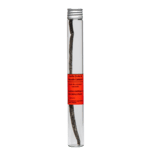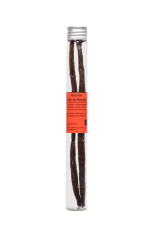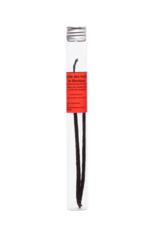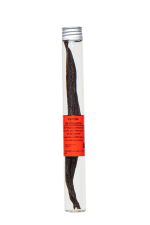Cave à Vanilles ® (“Vanilla Cellar”)

-
-

Gourmet Madagascar Vanilla Bean
- €13.50
-

Split Madagascar Vanilla Bean
- €13.50
-
Rare spices

Frosted New Caledonia Vanilla Bean
- €10.50
-

Tahitian Vanilla Bean (Raiatea Island)
- €11.30
-

Papua New Guinea Vanilla Bean
- €14.70
-

Uganda Vanilla Bean
- €14.45
-
 Cave à Vanilles ®What makes vanilla one of the most magical spices in the world is how it can evoke both the pure imagination of faraway places and the tenderness of childhood memories.
Cave à Vanilles ®What makes vanilla one of the most magical spices in the world is how it can evoke both the pure imagination of faraway places and the tenderness of childhood memories. -

Grande Comore Vanilla Bean
- €14.45
-

Tahitian Vanilla Bean (Tahaa Island)
- €11.30
-

Réunion Island Vanilla Bean
- €15.50
-

Vanilla from the forests of Mexico
- €14.70
-

Mayotte Vanilla Bean
- €15.50
-

French Guiana Vanilla Bean
- €12.50
-

Pompona Vanilla bean
- €11.30
-

Vanuatu Vanilla Bean
- €13.80
-

Sri Lanka vanilla bean
- €14.70
-

São Tomé Vanilla
- €15.50
-
Novelty

Pompona Vanilla Beans from Peru
- €11.50
-
Cave à Vanilles ® (“Vanilla Cellar”)
What makes vanilla one of the most magical spices in the world is how it can evoke both the pure imagination of faraway places and the tenderness of childhood memories.
Vanilla beans are expensive due to the complex, time-consuming processes that go into their growing, harvesting, and curing. Climate change has affected the bloom seasons of vanilla flowers, which makes premium, high-quality vanilla beans even harder to come by.
There are three main types of vanilla beans available today: Planifolia (Vanilla fragrans), tahitenis (Vanilla tahitensis), and pompona (Vanilla pompona ou Vanilla grandiflora). All are members of the orchid family.
Vanilla tahitenis, or Tahitian vanilla beans, are often used to make perfume fragrances and flavor chilled dessert recipes. Vanilla planifolia (fragrans) is the variety that is grown in Mexico, Madagascar, Uganda, the Comoros, Reunion Island, and the Vanuatu Islands. Rare Vanilla pompona thrives in French Guiana, Mexico, and the Antilles.
Come discover our range of vanilla beans in one of our spice boutiques or at the Cave à Vanilles® (Vanilla Cellar) in our shop in Paris.
THE HISTORY OF VANILLA
Vanilla beans are native to the Chiapas rainforest in Mexico, where wild vanilla flowers are pollinated by hummingbirds and indigenous melipone bees. To this day, wild vanilla still grows in the Chinantla forest. The Aztecs, as well as the Mayans and the pre-Columbian civilizations that came before them (Olmecs, Totonacs), had long mastered the fermentation techniques required to cure the beans. The Aztecs called vanilla beans "tlilxotchitl,” which means black flower. Vanilla beans were carefully prepared so that they could be used with cocoa in holy beverages that allowed those who drank them to communicate with the gods. The Totonacs were even required to pay certain taxes to Aztec kings with vanilla beans.
Europeans discovered vanilla beans much later when, in 1520, the Mexican Emperor Montezuma offered the Spanish explorer Cortés a drink made of chocolate and vanilla. Once Europeans had discovered vanilla’s seductive fragrance and flavor, they brought back small vanilla vine cuttings to grow elsewhere—first in greenhouses, then on other tropical islands like Reunion Island, the Mauritius Islands, and Madagascar. The vines grew and flowered, but no beans formed on the vines. After many attempts, European vanilla growers gave up on trying to cultivate vanilla beans, believing the Totonac Indians had kept the process a secret. Up until the middle of the 19th century, vanilla beans could only be “made” in Mexico. Although Europeans knew how to cure ripe beans, they did not know how to pollinate the vanilla flowers so that the beans would form on the vines. It wasn’t until 1840-1850 that Edmond Albius, a young slave, discovered how to hand-pollinate vanilla flowers using a thorn from a wild lemon tree. It is said that Albius was freed from slavery as a reward for his discovery.
From that time on, vanilla production spread rapidly throughout French overseas territories and in places where there was a strong French presence. These included Ile Bourbon (Reunion Island), Madagascar, Polynesia, and even the Papantla, near Veracruz, Mexico.
BOTANICAL DESCRIPTION AND PREPARATION
Vanilla beans are a fruit pod that grow on vanilla plants, which are members of the orchid family. Vanilla plants grow like vines, attaching themselves to trees as they climb. They are epiphyte, hermaphroditic plants with non-powdery pollen masses. Botanists have identified over 60 different vanilla species that grow in the wild, primarily in Mexico. In Southern Mexico, wild vanilla flowers are pollinated by hummingbirds and indigenous bees. Elsewhere, all cultivated vanilla flowers have been hand-pollinated since the 19th century. The painstaking process involves taking each flower and crushing the rostellum, a thin membrane which separates the flower’s stigmas from its pollen. After about 9 months, long, green vanilla beans with hints of yellow are ready to be harvested. At this stage, the vanilla beans are called “green vanilla.” They look like a large green beans and measure between 10 to 20 cm. Each bean is a seed pod which encases a small sac filled with tiny black seeds.
While vanilla beans are still on the vine, they give off a faint vanilla scent. Curing the beans is what develops their flavor and turns them a deep chocolate brown. The curing process for Vanilla planifolia beans begins with 24 hours of “scarring” just after they are picked. The beans are then are scalded several minutes. This step is part of the curing technique developed according to traditional Mexican methods by Ernest Loupy (1851), a grower on Reunion Island. After this step the beans are wrapped in large blankets for a 4-week (approximately) period when the beans (still wrapped in the blankets) are spread out to dry in the sun during the day, then brought inside at night to promote ideal fermentation conditions. Finally, the beans are laid on screens in well-aerated wood huts to cure for 6 months. During this time, the women workers give the beans’ skin a shiny smoothness by massaging them dozens of times with their hands. Finally, the beans are selected and sorted according to quality.
Both the men and women of the different vanilla growing regions around the world have developed cultivation, preparation, and curing techniques that vary according to the climate and the botanical vanilla species grown in order to yield the finest ‘grand cru’ vanilla beans.
“Choosing a favorite vanilla bean makes no sense to me. Vanilla bean plantations are like vineyards. And just as there are many wine makers whose products are mediocre, a select few have the knowledge and savoir-faire needed to produce a superlative product. When selecting premium vanilla beans, the terroir, millesime, climate and botanical species all matter, but it is above all else a question of who cultivates and cures the beans—and how.”Olivier Roellinger
VANILLA BEAN HINTS AND TIPS
When cooking with premium, high-quality vanilla beans, you can use much less than a recipe calls for.
For example: Recipes that yield 4 to 6 servings require just 1/3 of a vanilla bean to flavor them.
To cook with vanilla beans, first split the bean (or the piece of the vanilla bean) in half lengthwise with a sharp, small knife. Using the back of the knife, scrape out all of the small seeds inside the bean, and then them to the recipe.
- Count 1 vanilla bean per liter (quart) of liquid.
- Infusion time: 20 minutes to 2 hours
ANTI-WASTE TIP
Do not throw the bean away. Dry it in a turned-off oven, and you can use it in another recipe (cooking a fruit compote). You can dry it again before mixing it and then put it in a cane sugar bowl.
There are three main types of vanilla beans available today: Planifolia (Vanilla fragrans), tahitenis (Vanilla tahitensis), and pompona (Vanilla pompona ou Vanilla grandiflora). All are members of the orchid family.
Vanilla tahitenis, or Tahitian vanilla beans, are often used to make perfume fragrances and flavor chilled dessert recipes. Vanilla planifolia (fragrans) is the variety that is grown in Mexico, Madagascar, Uganda, the Comoros, Reunion Island, and the Vanuatu Islands. Rare Vanilla pompona thrives in French Guiana, Mexico, and the Antilles.
Come discover our range of vanilla beans in one of our spice boutiques or at the Cave à Vanilles® (Vanilla Cellar) in our shop in Paris.
THE HISTORY OF VANILLA
Vanilla beans are native to the Chiapas rainforest in Mexico, where wild vanilla flowers are pollinated by hummingbirds and indigenous melipone bees. To this day, wild vanilla still grows in the Chinantla forest. The Aztecs, as well as the Mayans and the pre-Columbian civilizations that came before them (Olmecs, Totonacs), had long mastered the fermentation techniques required to cure the beans. The Aztecs called vanilla beans "tlilxotchitl,” which means black flower. Vanilla beans were carefully prepared so that they could be used with cocoa in holy beverages that allowed those who drank them to communicate with the gods. The Totonacs were even required to pay certain taxes to Aztec kings with vanilla beans.
Europeans discovered vanilla beans much later when, in 1520, the Mexican Emperor Montezuma offered the Spanish explorer Cortés a drink made of chocolate and vanilla. Once Europeans had discovered vanilla’s seductive fragrance and flavor, they brought back small vanilla vine cuttings to grow elsewhere—first in greenhouses, then on other tropical islands like Reunion Island, the Mauritius Islands, and Madagascar. The vines grew and flowered, but no beans formed on the vines. After many attempts, European vanilla growers gave up on trying to cultivate vanilla beans, believing the Totonac Indians had kept the process a secret. Up until the middle of the 19th century, vanilla beans could only be “made” in Mexico. Although Europeans knew how to cure ripe beans, they did not know how to pollinate the vanilla flowers so that the beans would form on the vines. It wasn’t until 1840-1850 that Edmond Albius, a young slave, discovered how to hand-pollinate vanilla flowers using a thorn from a wild lemon tree. It is said that Albius was freed from slavery as a reward for his discovery.
From that time on, vanilla production spread rapidly throughout French overseas territories and in places where there was a strong French presence. These included Ile Bourbon (Reunion Island), Madagascar, Polynesia, and even the Papantla, near Veracruz, Mexico.
BOTANICAL DESCRIPTION AND PREPARATION
Vanilla beans are a fruit pod that grow on vanilla plants, which are members of the orchid family. Vanilla plants grow like vines, attaching themselves to trees as they climb. They are epiphyte, hermaphroditic plants with non-powdery pollen masses. Botanists have identified over 60 different vanilla species that grow in the wild, primarily in Mexico. In Southern Mexico, wild vanilla flowers are pollinated by hummingbirds and indigenous bees. Elsewhere, all cultivated vanilla flowers have been hand-pollinated since the 19th century. The painstaking process involves taking each flower and crushing the rostellum, a thin membrane which separates the flower’s stigmas from its pollen. After about 9 months, long, green vanilla beans with hints of yellow are ready to be harvested. At this stage, the vanilla beans are called “green vanilla.” They look like a large green beans and measure between 10 to 20 cm. Each bean is a seed pod which encases a small sac filled with tiny black seeds.
While vanilla beans are still on the vine, they give off a faint vanilla scent. Curing the beans is what develops their flavor and turns them a deep chocolate brown. The curing process for Vanilla planifolia beans begins with 24 hours of “scarring” just after they are picked. The beans are then are scalded several minutes. This step is part of the curing technique developed according to traditional Mexican methods by Ernest Loupy (1851), a grower on Reunion Island. After this step the beans are wrapped in large blankets for a 4-week (approximately) period when the beans (still wrapped in the blankets) are spread out to dry in the sun during the day, then brought inside at night to promote ideal fermentation conditions. Finally, the beans are laid on screens in well-aerated wood huts to cure for 6 months. During this time, the women workers give the beans’ skin a shiny smoothness by massaging them dozens of times with their hands. Finally, the beans are selected and sorted according to quality.
Both the men and women of the different vanilla growing regions around the world have developed cultivation, preparation, and curing techniques that vary according to the climate and the botanical vanilla species grown in order to yield the finest ‘grand cru’ vanilla beans.
“Choosing a favorite vanilla bean makes no sense to me. Vanilla bean plantations are like vineyards. And just as there are many wine makers whose products are mediocre, a select few have the knowledge and savoir-faire needed to produce a superlative product. When selecting premium vanilla beans, the terroir, millesime, climate and botanical species all matter, but it is above all else a question of who cultivates and cures the beans—and how.”Olivier Roellinger
VANILLA BEAN HINTS AND TIPS
When cooking with premium, high-quality vanilla beans, you can use much less than a recipe calls for.
For example: Recipes that yield 4 to 6 servings require just 1/3 of a vanilla bean to flavor them.
To cook with vanilla beans, first split the bean (or the piece of the vanilla bean) in half lengthwise with a sharp, small knife. Using the back of the knife, scrape out all of the small seeds inside the bean, and then them to the recipe.
- Count 1 vanilla bean per liter (quart) of liquid.
- Infusion time: 20 minutes to 2 hours
ANTI-WASTE TIP
Do not throw the bean away. Dry it in a turned-off oven, and you can use it in another recipe (cooking a fruit compote). You can dry it again before mixing it and then put it in a cane sugar bowl.